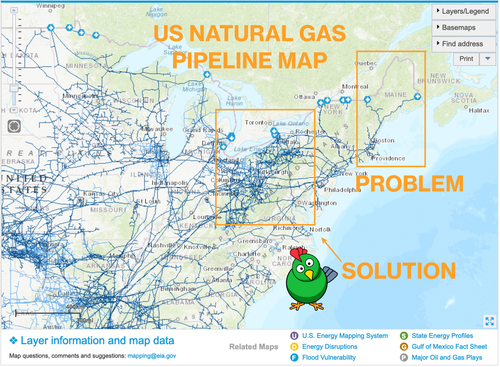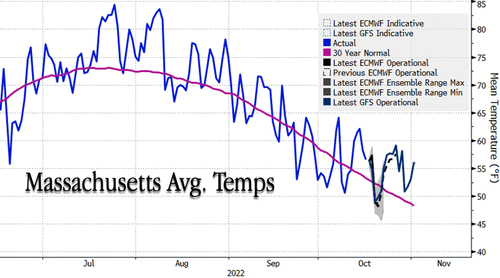Last month we informed readers, “New England’s Power Crisis Set To Return.” Fast forward to today, as US Northeast temperatures steadily decline as heating demand increases, New England power producers warn grid strains are inevitable as natural gas supplies tighten.
New England consists of six states in the US Northeast, Connecticut, Maine, Massachusetts, New Hampshire, Rhode Island, and Vermont. The region faces a power crisis every winter because its power grid relies on NatGas and lacks pipeline infrastructure for domestic flows. Over the years, NatGas pipeline infrastructure has been delayed, blocked, or abandoned, which means the region’s power-grid operators have to compete in international markets for supplies.

WSJ reported that power-grid operator, ISO New England Inc., warned a colder-than-normal winter “could strain the reliability of the grid and potentially result in the need for rolling blackouts to keep electricity supply and demand in balance.”
ISO New England’s top executives said if power producers have to increase NatGas deliveries due to severe weather drawing down supplies, it would indicate they would be paying international spot-market purchases.
“The most challenging aspect of this winter is what’s happening around the world and the extreme volatility in the markets,” said Vamsi Chadalavada, the grid operator’s chief operating officer. “If you are in the commercial sector, at what point do you buy fuel?”
One major problem is that power producers have limited NatGas storage facilities and lack pipeline capacity reserved mainly by utilities serving homes and businesses. Power producers procure a portion of supplies with fixed-price agreements and mostly rely on spot markets.
“Anybody who is depending on the spot market for their natural-gas supply is probably going to have a pretty significant sticker shock,” said Tanya Bodell, a partner at consulting firm StoneTurn who advises energy companies in New England.
We pointed out last year, “New England Is An Energy Crisis Waiting To Happen,” and the worsening supply woes in Europe and the world means NatGas spot markets will be elevated through the cold season.
New England had the bright idea to decommission coal, oil, and nuclear generators, leaving the grid exposed to NatGas. New England ISO figures show about 5,200 megawatts of that capacity have retired in the last decade.
The region’s power mix changes have left it increasingly reliant on international NatGas spot markets. State governors have asked US Energy Secretary Jennifer Graholm to waive the Jones Act and allow foreign-owned tankers to ship LNG from the US Gulf region.
All of this has led to New England residents facing some of the highest electricity bills in years. Heating season is already underway.

New England ISO expects the grid will be stable if there’s a mild-to-moderate winter. However, if there’s an extreme cold spell across the Northeast, then grid chaos could unfold:
“The grid overall is in a much tighter position.
“If we get a sustained cold period in New England this winter, we’ll be in a very similar position as California was this summer,” Nathan Hanson, a senior vice president of energy and commercial management of LS Power Development LLC, which has two NatGas power plants in New England, warned.
This post was originally published at Zero Hedge